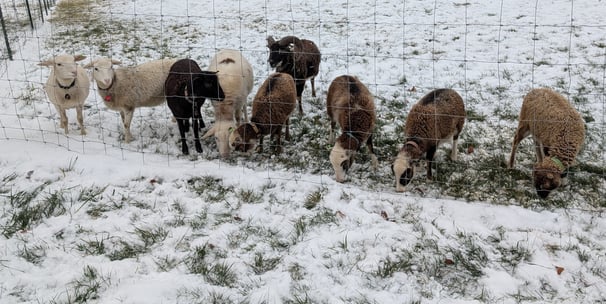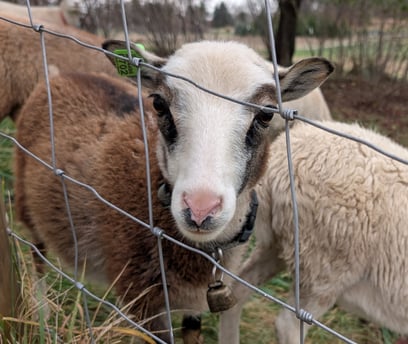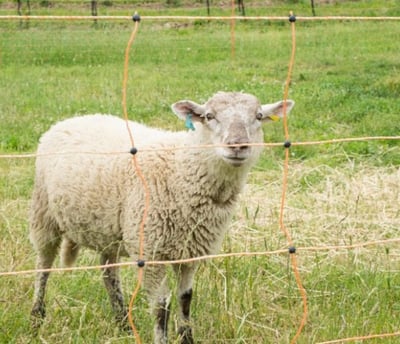Sheep Feeding & Nutrition: A Comprehensive Guide
Understanding and managing your flock's nutrition is fundamental to raising healthy, productive sheep. Their needs aren't static; they change significantly throughout the year based on their reproductive stage. Meeting these changing demands prevents health issues, ensures ewe longevity, maximizes lamb survival, and promotes optimal growth.


Understanding the Basics
Before diving into specific stages, let's cover some core principles:
The Ruminant System: Sheep are ruminants, meaning they have a specialized four-compartment stomach designed to digest fibrous plant matter. This system relies on a delicate balance of microbes. Always introduce any feed changes slowly, ideally over 7-10 days, to allow these microbes time to adapt. Sudden changes can lead to serious digestive upsets like bloat or acidosis.
Body Condition Scoring (BCS): This is your most valuable hands-on tool for managing nutrition. It involves feeling the amount of muscle and fat over the sheep's loin (spine and short ribs). Using a 1-5 scale (1=emaciated, 5=obese), you can visually and physically gauge if your ewes are too thin, too fat, or just right for their current stage. Regularly scoring your ewes allows you to fine-tune their feed.
Forage: The Foundation: Pasture during the growing season and good-quality hay during the non-growing season should form the bulk of every sheep's diet. Offer free-choice hay when pasture isn't available. A mix of grass hay and alfalfa is often ideal. Alfalfa provides higher protein and calcium, which is especially beneficial during late pregnancy and lactation.
Water: The Essential Nutrient: Sheep need constant access to fresh, clean water. Requirements increase dramatically during hot weather, late pregnancy, and especially during lactation (nursing ewes can drink over 2 gallons a day!). Consider heated buckets or tank de-icers for Michigan winters, and investigate automatic float valves to save significant labor.
Minerals: The Balancing Act: Provide free-choice, loose sheep-specific minerals and salt at all times.
CRITICAL COPPER WARNING: Sheep are highly sensitive to copper, and too much can be fatal. NEVER use minerals or feeds designed for cattle or goats, as they contain high levels of copper. Double-check all feed bags (look for "sheep-safe" labels or guarantees) and AVOID all-purpose or green-colored mineral blocks, which usually contain added copper.
Grain: The Strategic Supplement: Grain is a source of concentrated energy and protein, used to supplement forage, not replace it. It's useful during specific high-demand periods:
Flushing: Before and during early breeding.
Late Gestation & Lactation: For ewes carrying/nursing lambs.
Growing Lambs: For finishing/growth.
Training: A little bit goes a long way!
If using grain, ensure it's "sheep-safe" (no added copper) and feed appropriately – often starting around 0.5 lb and increasing to 1-3 lbs during peak demand, usually split into two feedings.
Nutritional Needs Through the Ewe's Cycle
Here’s how a ewe’s needs change throughout the year:
1. Maintenance (Dry Period)
When: Ewe is not pregnant and not lactating (e.g., after weaning, before flushing).
Goal: Maintain a healthy weight (BCS 2.5 - 3.0).
Needs: Lowest demand. CP: ~9-10%; TDN: ~50-55%.
Strategy: Good pasture or average hay is usually sufficient. Grain is typically unnecessary.
2. Flushing
When: 2-4 weeks before and 2-4 weeks into breeding season.
Goal: Increase energy to boost ovulation rates and improve conception (Target BCS 3.0 - 3.5).
Needs: Increased energy. CP: ~11-12%; TDN significantly increased.
Strategy: Move to lush pasture or supplement with 0.5-1 lb of grain/day (introduce gradually). Avoid pure legume pastures (LSU AgCenter, 2025).
3. Early Gestation (First ~50 Days)
When: The first third of pregnancy.
Goal: Maintain pregnancy and condition (Target BCS 3.0 - 3.5). Fetal growth is minimal.
Needs: Slightly above maintenance. CP: ~10%; TDN: ~55% (New Mexico State University, n.d.).
Strategy: Good pasture or average hay is usually adequate. Monitor BCS to prevent loss.
4. Mid Gestation (Days ~50-100)
When: The second third of pregnancy.
Goal: Maintain condition, support placental growth (Target BCS 3.0 - 3.5).
Needs: Slight increase over early gestation. CP: ~10-11%.
Strategy: Good quality forage usually suffices. Plan for late gestation needs (FAS, 2021).
5. Late Gestation (Last ~50 Days)
When: Final 6-7 weeks before lambing. This is a critical period.
Goal: Support rapid fetal growth (70-80% occurs now), udder development, prevent disease (Target BCS 3.0 - 3.5).
Needs: Dramatically increased, especially with multiples. Rumen capacity shrinks. CP: 12-15%+; TDN: 60-70%+. Ewes with twins/triplets need significantly more (Michigan State University Extension, n.d.).
Strategy: High-quality forage + grain supplementation is almost always necessary. Gradually increase grain to 1.5-2 lbs/day (split feed), especially for ewes carrying multiples. Inadequate energy risks fatal Pregnancy Toxemia (W.E. Jameson & Son, n.d.).
6. Lactation (Nursing Period)
When: From lambing to weaning.
Goal: Maximize milk production (Aim to keep BCS above 2.5).
Needs: Highest demand, especially first 6-8 weeks and with multiples. CP: 14-16%+; TDN: 65-75%+.
Strategy: Best quality forage + significant grain (1-3 lbs/day, split feed). Ensure adequate bunk space and lots of clean water (Virginia Tech, n.d.).


Key Takeaways
Observe: Regularly monitor your sheep's Body Condition Score and adjust feeding accordingly.
Test Forage: Knowing your hay's nutritional value is the best way to supplement accurately.
Prioritize Water & Minerals: Ensure constant access to clean water and safe sheep minerals.
Go Slow: Always transition feeds gradually.
By understanding and responding to these changing nutritional needs, you provide the foundation for a thriving, productive flock.


Understanding Feed Terms (CP & TDN)
When you see nutritional requirements listed, you'll often encounter "CP" and "TDN" percentages. These values are usually expressed on a Dry Matter Basis (DMB), meaning they measure nutrients as if all water was removed, allowing for fair comparisons between feeds. Here's what they mean:
CP (Crude Protein):
What it is: The standard measure of total protein in a feed, estimated from its nitrogen content (Oregon State University Extension, n.d.).
Why it matters: Protein is vital for building body tissues, muscle, wool, fetuses, and milk (University of Georgia Extension, 2023).
The %: Indicates how much of the feed's dry matter is protein. A "9-10% CP" diet is low-protein (for maintenance), while a "14-16% CP" diet is high-protein (for peak lactation).
TDN (Total Digestible Nutrients):
What it is: The most common measure of the energy content in feed for sheep (University of Nebraska-Lincoln, n.d.). It estimates the total energy available from digestible protein, fiber, carbs, and fats.
Why it matters: Energy fuels all life processes, from walking to growing lambs. It's often the most critical nutrient.
The %: Indicates how much of the feed's dry matter provides energy. A "50-55% TDN" diet is lower-energy (for maintenance), while a "65-75% TDN" diet is high-energy (for peak lactation) (Mississippi State University Extension, n.d.).
~ (Approximately): Remember, these percentages are excellent guidelines. Actual needs vary with breed, size, age, environment, and forage quality.
References
FAS. (2021). Sheep Nutrition – Pre-Tupping and Mid-Pregnancy.
Hook Norton Veterinary Group. (2022). Body Condition Scoring in Sheep.
LSU AgCenter. (2025). Sheep Breeding Season.
Merck Veterinary Manual. (n.d.). Nutritional Requirements of Sheep.
Michigan State University Extension. (n.d.). Feeding Ewes by Stage of Production.
Montana State University. (n.d.). Monitoring Sheep Nutrition Needs.
New Mexico State University. (n.d.). Sheep Production and Management.
Virginia Tech. (n.d.). Sheep Nutrient Requirements & Feed Composition.
W.E. Jameson & Son. (n.d.). Sheep Nutrition.
Washington State University. (n.d.). Feeding Sheep.
